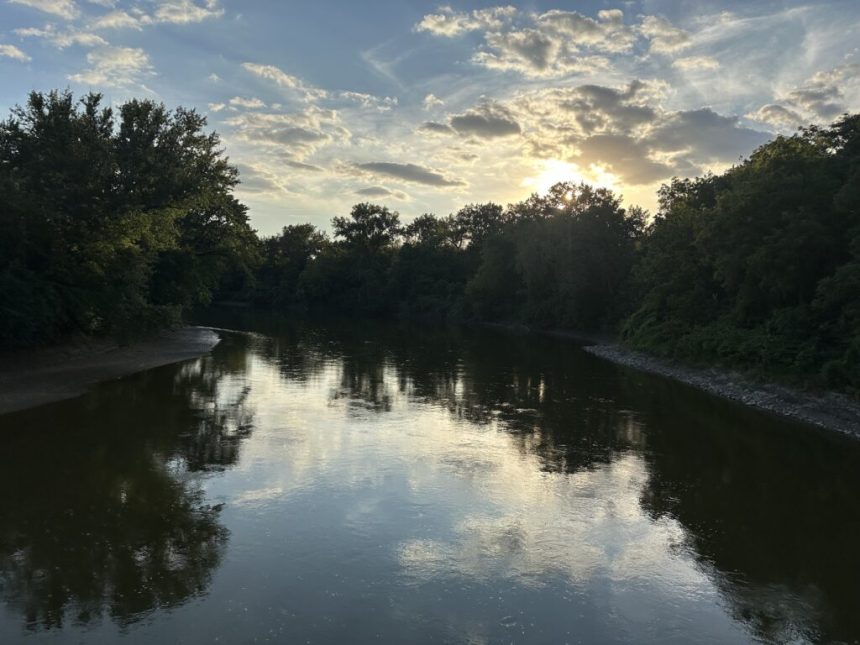The Raccoon River as it flows under the Bill Riley Trail Bridge in Des Moines on Sept. 2, 2025. (Photo by Cami Koons/Iowa Capital Dispatch)
The Izaak Walton League of America’s Iowa division has started a grassroots campaign to raise funds for a water quality monitoring program, formerly funded by the state, at the University of Iowa.
The Iowa Water Quality Information System, or IWQIS, gives real-time measures of pH, nitrate, dissolved oxygen, discharge rates and temperature in streams across the state. But funding for the program was diverted by the state Legislature in 2023 and the system is poised to shut down if funding doesn’t come through by July 2026.
Dale Braun, president of the Iowa Division of the Izaak Walton League of America, said the monitoring network plays a “vital role” in protecting public health and “environmental resilience” for rural and municipal water systems.
SUBSCRIBE: GET THE MORNING HEADLINES DELIVERED TO YOUR INBOX
“Without it, Iowans lose transparency and accountability during a worsening water quality crisis,” Braun said in a news release.
Larry Weber, director of hydroscience and engineering in the College of Engineering at UI, said the IWQIS program received about $500,000 from Iowa State University’s Nutrient Research Center, until the 2023 state budget for agriculture and natural resources diverted the funds.
Weber said IWQS, which put out its own sensors and collected data from water quality sensors managed by the U.S. Department of Agriculture and the U.S. Geological Survey, was the best collection of real-time water quality data in the state.
“Not only in this state, but in any state,” Weber said. “What we’ve built here is really best in class in terms of water quality monitoring and information sharing.”
Weber said IWQIS is often looked at as “telling the bad side of the story” because it highlights spots along Iowa streams that have high concentrations of nitrate, or other nutrients. But, he said, the monitoring also shows where water quality initiatives are making a difference and reducing the concentration of nutrients in Iowa waterways.
Weber said the system was able to secure part-time funding through the Walton Family Foundation, which will keep it running until the beginning of July 2026.
“If we’re not able to find replacement funding … the water quality information system will be shut down,” Weber said.
The Izaak Walton League initiative aims to raise $500,000, which it said would keep the network running at its “most basic capacity.” Funding at $600,000, the news release noted, would allow the program to fully fund its operations while renewing equipment and supporting professional data work.
“We’re very appreciative of what they’re doing,” Weber said of the Izaak Walton League campaign, noting it was independent of the UI department. “We would happily accept those funds to help our program.”
At its peak, Weber said, the system put out about 60 sensors, which were complemented by the nearly 30 sensors USDA and USGS have on Iowa rivers.
Right now, Weber said IWQIS has reduced the number of sensors it puts out to about 50 — if funding doesn’t come through, all of those sensors will be pulled, leaving just around 30 in place from the federal agencies.
As part of the Gulf of Mexico hypoxia task force, Midwestern states, including Iowa, are meant to reduce the concentrations of nutrients entering the Mississippi River.
Weber said as nitrate levels in Iowa streams continue to be high, as noted by the IWQIS data, the state is headed “in the wrong direction.”
The fundraising efforts will be highlighted at the upcoming Iowa Nature Summit at Drake University.
Neil Hamilton, the summit’s organizer, said the fundraising project is “critical.”
“One of our core goals is to identify concrete actions Iowans can take to protect our natural resources,” Hamilton said in the news release with Izaak Walton League. “Funding the water monitors gives us the information needed to make smarter decisions about improving Iowa’s water quality.”









